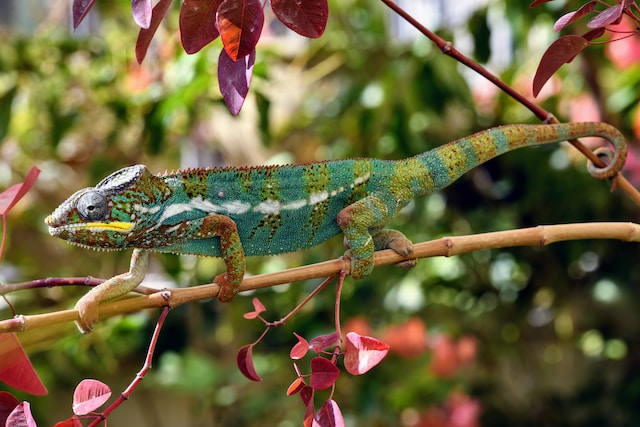
The Panther Chameleon (Furcifer pardalis) is undoubtedly one of the most captivating reptiles in the world. With its vibrant colors, unique patterns, and remarkable ability to change its skin hue, this species has become a popular choice among reptile enthusiasts and pet owners. In this article, we will explore the suitability of the Panther Chameleon as a pet and provide instructions on how to care for these extraordinary creatures.
The Panther Chameleon is native to the rainforests and coastal areas of Madagascar, an island off the southeastern coast of Africa. These arboreal reptiles are known for their striking appearance and remarkable color-changing capabilities, which they use for communication, thermoregulation, and camouflage. Adult males can reach a length of around 17-21 inches, while females tend to be slightly smaller, measuring about 10-13 inches.
When considering the Panther Chameleon as a pet, it’s important to understand that they require a significant amount of care and attention. While their beauty may be enticing, their complex needs make them more suitable for experienced reptile keepers. Novice pet owners should gain some experience with easier-to-care-for reptiles before considering the Panther Chameleon.
One of the most critical aspects of Panther Chameleon care is providing them with an appropriate habitat. An adequately sized enclosure is essential to ensure their well-being. A screen or mesh enclosure is recommended to maintain proper ventilation and humidity levels. The enclosure should be tall, with ample climbing branches and foliage to replicate their natural habitat. It is crucial to provide a range of temperatures within the enclosure, including a basking spot with temperatures between 85-95°F and a cooler area around 75-80°F.
Maintaining proper humidity levels is vital for the Panther Chameleon’s health. Relative humidity should be around 50-70%, with occasional misting of the enclosure to increase humidity. Additionally, a drip system or a misting device can be used to provide them with drinking water, as they tend to drink droplets from leaves.
A varied and balanced diet is essential for the Panther Chameleon’s overall well-being. Their diet primarily consists of live insects, such as crickets, roaches, and silkworms. It is important to provide a diverse range of gut-loaded insects dusted with calcium and vitamin supplements to ensure proper nutrition. Additionally, offering occasional treats like waxworms or mealworms can help add variety to their diet. Fresh fruits, such as mangoes or papayas, can also be offered in moderation.
Regular veterinary check-ups are crucial for the health and well-being of your Panther Chameleon. Finding a reptile-experienced veterinarian is highly recommended to ensure proper care and address any potential health issues.
In conclusion, the Panther Chameleon is an exquisite and captivating reptile that requires careful attention and specialized care. While it may not be the ideal pet for beginners, experienced reptile keepers can find immense joy in providing a suitable environment and meeting the unique needs of these incredible creatures. With proper care, the Panther Chameleon can thrive and become a cherished addition to any reptile enthusiast’s collection.
10 Fun Facts About Panther Chameleons
Colorful Camouflage
Panther Chameleons are renowned for their exceptional color-changing abilities. They can alter their skin color and patterns to blend in with their surroundings, communicate with other chameleons, regulate body temperature, and even display their mood.
Vivid Range of Colors
These chameleons exhibit an astonishing array of colors, including various shades of green, blue, red, orange, yellow, and brown. The intensity and combination of colors can vary depending on their mood, environmental factors, and social interactions.
Impressive Size Change
Panther Chameleons undergo significant growth and size changes throughout their lifespan. Baby chameleons are incredibly tiny, around two inches long, while adult males can grow up to 17-21 inches in length.
Extreme Tongue Length
To catch their prey, Panther Chameleons utilize their long, extendable tongues. Their tongues can extend at an incredible speed, reaching lengths up to twice their body length, allowing them to capture insects with remarkable precision.
Eye Movement and Independent Vision
Chameleons have unique eye structures that enable them to move their eyes independently, providing a panoramic view of their surroundings. They can simultaneously focus on two different objects, allowing them to scan for potential threats or prey effectively.
Casque and Horn-Like Structures
Adult male Panther Chameleons develop prominent casques, which are bony crests on the top of their heads. Additionally, some males develop horn-like projections on their snouts, giving them a distinct appearance.
Arboreal Lifestyle
Panther Chameleons are arboreal creatures, spending most of their time in trees and shrubs. Their specialized feet and prehensile tails help them grip branches and navigate their arboreal habitats with ease.
Long Lifespan
With proper care, Panther Chameleons can live relatively long lives. Males typically live for 5-7 years, while females can live up to 3-4 years longer.
Pivotal Role in Madagascar’s Ecosystem
As native inhabitants of Madagascar, Panther Chameleons play a crucial role in the island’s ecosystem. They help control insect populations and serve as indicators of environmental health.
Unique Birthing Process
Unlike most reptiles, Panther Chameleons are live-bearers rather than egg-layers. Female chameleons give birth to live young, with litters ranging from 6 to 30 babies.
Related Articles & Free Email Newsletter Sign Up
5 Good Choices for a Lizard Pet
How and Why a Chameleon Changes its Body Color

Comment here